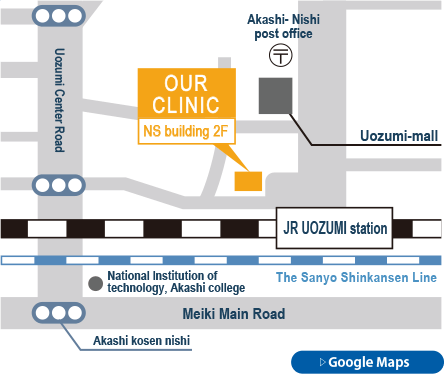OSTEOPOROSIS / RHEUMATISM
What is osteoporosis?
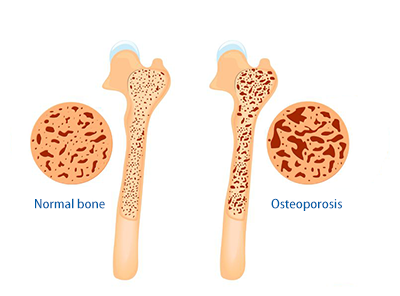
- Bone masses decrease by aging, and bones become broken easily
- Beginning with aging, lack of calcium and exercise, smoking, drinking and menopause (decrease in female sex hormone) can cause a decrease in bone masses (the mass of the bone, calcium or collagen) therefore a bone becomes fragile as if a void entered and this condition is known as osteoporosis.
When it occurs, not only does the bone become broken easily with a slight shock, since this is a symptom unique to the elderly, it increases the chance for a need in nursing care. - No subjective symptoms can be found with the decrease in bone mass
- The bone mass gradually decreases with age, the peak being 20-30 year olds.
It becomes the condition of the osteoporosis due to this bone mass or bone density (bone mass per unit volume) decreasing.
Because there is not a single subjective symptom regarding the decrease of bone mass, you tend to notice it most times when you have broken a bone. The most bone fracture points occur with the backbone, and the second one is the wrist.
Furthermore, when one reaches the age of over 70, the proximal part of the thigh bone (the bone of the root of the foot) can be easily broken.
Since this bone plays a very important role in supporting the body, you may be in a bedridden condition when you break the bone. - Women to be examined once before they turn 50 years old
- In addition, the 80% of the osteoporotic patient is women and, in particular, it is frequent after the climacteric age when secretion of the female sex hormone (estrogen) decreases.
We recommend women receive osteoporosis inspection before reaching the age of 50.
In addition, unbalanced and extreme diet, smoking or excess in drinking are regarded as the cause of osteoporosis. The osteoporosis of young women is viewed as problematic.
About inspection of osteoporosis
We conduct osteoporosis inspection at our clinic. The method of the inspection is an inspection for bone density, the inspection of the bone metabolism marker, X-ray check, and height measurement.
The details of each examination are as follows.
- Bone density measuring
-
「Using a standard known as “bone density” which judges the strength of the bone, it is an examination to measure the mass of the bone per volume.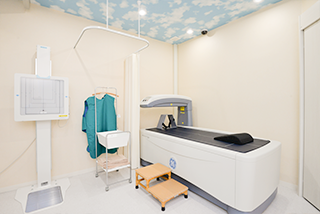
At the time of measurement, we perform the measurement of the body density (the DXA method) using a systematic bone density measurement device (DXA) equipped for the whole body.
The DXA method (dual-energy X-ray absorptiometry :) Double energy X-ray absorption assay) is a method by which it irradiates the two different kinds of X-rays at the measurement point and by doing so analyzes the transmittance with a computer checks the bone mass.
This method calculates the bone mass which is divided by unit area and expresses it as "bone density”.
A bone which is to be measured can be lumbar vertebrae (bone of the waist), and a thigh bone (bone of the root part of the thigh).
Not only can this method be done in a short time, the error is small, there is less doses of absorbed radiation, and so it is known to have a merit for being superior to safety. - Examination of the bone metabolism marker
- Bone resorption and formation balance is identified by inspecting "a bone metabolism marker" with blood and urine. When this balance collapses, the bone becomes weak.
In addition, a bone fracture risk becomes higher regardless of a value of the bone density because the drop speed of the bone density is fast for people having a high bone metabolism marker indicating bone resorption. - X‐ray examination
-
It is a necessary examination to distinguish between osteoporosis and other diseases.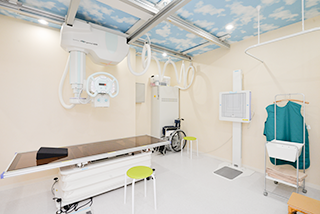
We take the X-rays of the backbone (thoracic vertebra and lumbar vertebrae), and we confirm whether there is a bone fracture or transformation or not. Also we view with our eyes to examine the presence of "osteoporosis (if a bone is in a porous condition or not)" - The height measurement
- We measure how short the height has shrunk compared to the height at the age of 25 years old.
If the height has shrunk more than 4cm in comparison to the height at 25 years old, it is reported that the risk to be fractured is doubled compared to a person who did not shrink much.
This examination is very important in examining whether a person is diagnosed with osteoporosis or not.
About treatments for osteoporosis
Lifestyles such as a meal, the exercise greatly is related to the onset of the osteoporosis as well as aging and menopause.
In other words, dietary and exercise therapy is necessary for treatment prevention in the same way as a lifestyle-related disease.
In addition, when you receive a diagnosis of the osteoporosis, the main treatment becomes what is known as pharmacotherapy.
- Dietary therapy
-
With dietary therapy, we work towards the intake of nutrients required for treatment and prevention such as the intake of calcium and the protein as well as vitamin D and K which are required for remodeling of the bone.
It is recommended that you take in 250~300μg /day of calcium, 700~800mg /day of vitamin K, 400~800IU/ day of vitamin D.
It is important to lead a well-balanced eating lifestyle by actively taking these nutrients.
In addition, food we should be careful of excessive intake includes alcohol and caffeine and phosphorus (a snack cake and convenience food).Consumption of too much alcohol increases the excretion quantity of calcium from urine and obstruct the absorption of calcium.
Caffeine promotes excretion of calcium in the same way, too.In addition, if you consume too much phosphorus, the bone density decreases because calcium in the bone is released in the blood trying to keep the balance of calcium and phosphorus in blood.
*Remodeling: a metabolic effect by the osteoblast which functions to make bones try to make a new bone on the part that was absorbed by the osteoclast while the function of the osteoclast is to destroy the bone.
The nutrient-rich food Calcium Milk, dairy products, dried prawns, brown alga, pond smelt, sardine, shishamo smelt, soybean product, pea, Japanese mustard spinach, the molokheiya Protein Meat, fish, egg, dairy products, soybean product Vitamin D The liver of angelfish, dried whitebait, whole of the sardine dried, salted salmon roe, salmon, saury, flatfish, eel, dried small sardines, and shiitake comes bean jam, jellyfishes Vitamin K Natto, powdered green tea, broccoli, cabbage, sunny lettuce, molokheiya, garland chrysanthemum, saltwort, Japanese mustard spinach, spinach, rape, radish sprout, Chinese chives - Exercise therapy
-
The bones increase and become strong by experiencing weight load through exercise.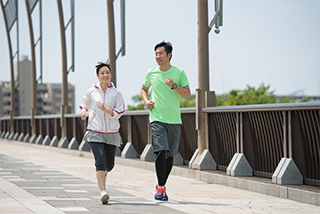
Furthermore, strengthening muscle will allow the body to become well supported, thus a sense of balance improves and results in preventing falling.
You don’t need aerobic exercise to increase bone masses.Even exercise such as walking is effective enough, therefore it is important to continue it for a long time, if it is possible every day, or even several times in a week. - Pharmacotherapy
-
When you receive a diagnosis of the osteoporosis, in addition to dietary therapy and exercise therapy, pharmacotherapy will also begin.
The medicine currently used is as follows.
The medicine which controls destruction for bone Bisphosphonate preparation It promotes bone formation by controlling bone resorption and increases bone density.
It is currently a first-line drug of this treatment and it is known to have high effectiveness as a therapeutic drug for osteoporosis.
Bisphosphonate is absorbed in the intestines and reaches the bone immediately.And it acts on osteoclast and controls excessive bone resorption.If bone resorption becomes slow, bone formation catches up, and ribs with high density is generated.Selective estrogen receptor operation medicine Bones have a similar effect to that of the estrogen (female sex hormone) where they restrain a rib from being broken and increases bone mass. Human anti RANKL monoclonal antibody preparation It is effective in controlling the destruction of the bone and it prevents creating cells which destroy bones.As a result, the bone masses increases, and the risk of a bone fracture decreases. This medicine can be taken with the hypodermic injection once in six months (six months preparation) Medicine which compensates materials for the bone Calcium preparation It is used in cases where calcium intake is lacking due to meals, patients with milk sugar intolerance symptom and after stomach and intestine operations.Most are used together with other agents. Activate vitamin D3 preparation Activate vitamin D3 functions to promote calcium absorption from the intestinal canal, and increases the quantity of calcium within the body. In addition, it promotes bone formation. Vitamin K2 preparation Vitamin K2 promotes bone formation by acting on osteoblasts and controls the balance of bone metabolism by restraining bone resorption and at the same time improves the quality of the bone. Medicine to make bones Parathyroid hormone preparations This medicine promotes bone formation to increase bone masses and to decrease bone fractures.There are medicines done by self-injection using an exclusive kit once a day, and a medicine injected at a medical institution once a week.Bone density decreases remarkably and is used for a patient having high bone fracture risk.
What is rheumatism?
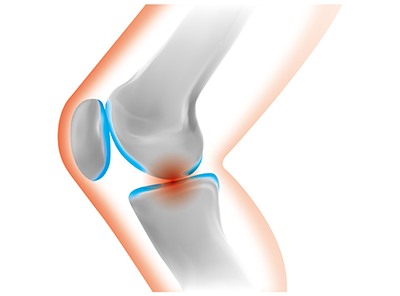
- Hand and foot joint inflames due to immunity going out of control
- Rheumatism (rheumatoid arthritis) occurs when the immunity instead of attacking foreign enemies (such as disease-causing germs) as it should, goes out of control and starts attacking its own immunity, joints such as hands and feet swell up, and aches.
Inflammation may not only be limited to joints but can spread to the whole body such as the eyes or the lungs and moreover experience symptoms such as a slight fever and lassitude and loss of appetite.
When a symptom progresses more, a small loss part (bone sore) can be made in the bone and cartilage, the joint can become destructed or transformed, and one may experience obstacles with daily life. - The ratio of women is high and the onset of diagnosis are mainly between the age of 30~50.
- Rheumatism is one of collagenosis. It is mainly diagnosed by people between the age of 30-50, and the number of women patients are three to four times more than that of men is also a characteristic.
Apart from this, there are young people lower than high school students or those over the age of sixty who also become diagnosed. It is said that heredity is related to the onset, however, even if there is rheumatic patient in the family, it does not necessarily mean that you will become diagnosed. - Numbness or the pain of hands and feet are early symptoms
- Furthermore, rheumatism has some early symptoms. The main symptoms include the stiffness of the knuckles of hands and feet in the early morning, several places of joints start hurting and the numbness of the hands and feet.
If any of the symptoms above seem to fit, we recommend that you receive a rheumatic diagnosis once. We conduct rheumatism examination at our clinic.
About rheumatic examination
- There are many diseases which have similar symptoms, therefore we check it very carefully.
-
In order to confirm the diagnosis of rheumatism, we start with the interview and by comparing the results of a blood test, X-ray check and the joint echo check we make a general judgement.
There are many diseases which have similar symptoms, therefore we check it very carefully.To give examples of similar symptoms, osteoarthritis is a disease many middle-aged woman are diagnosed with where the first joint of the finger swells up hard, however this is not rheumatism.
On the other hand, the gout which many male patients experience can cause aches when the thumb of the foot swells up; however it can be distinguish from rheumatism because there is relatively little that inflammation which occurs with other joints.
About a rheumatic cure
A main rheumatic cure includes pharmacotherapy and surgical treatment.Even if it is the same treatment, the method can differ.
- Pharmacotherapy
-
- It slows down the rheumatic progress and can make prevention of joint destruction possible.
- Regarding pharmacotherapy, with the intake of Methotrexate, an anti-rheumatic drug that treats rheumatism by immunosuppressive action and introduction of biological preparation which is superior in restraining joint destruction, not only did it succeed in relieving inflammation and pain but also was able to start preventing progress of illness and joint destruction.
With latest rheumatic treatment, we aim for a treatment with a goal of remission, that is the symptom of the illness lightens temporarily or continuously or apparently gone (lost in appearance) while examining rheumatic activity. When it never reaches remission, we try our best to get the inflammation controllable to some extent.
Normally, if we are unable to control enough rheumatism within three months, we change medicine or add medicine to aim a state close to remission. After having entered remission by treatment, it is important to maintain remission.Even if you may feel the symptoms improved there is a possibility of recurrence if you decide to reduce your medicine in a selfish manner, so please follow the instructions of the physician in charge by all means. - By doing rehabilitation together it can suppress the functional disorder of the joint
-
It is medical treatment which is expected to have an effect to relieve pain and inflammation.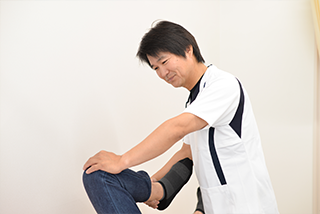
However, the joint may become stiff if you do not move it. Therefore it is “rehabilitation” which allows you to maintain excursion by always moving the joint, and helps you enlarge it. If you do rehabilitation every day repeatedly and patiently for a long term, the functional disorder of the joint can be suppressed, and the pain will also be relieved.
- Surgical treatment
-
- We support daily life with an artificial joint
-
The surgical treatment is provided when a pain is not relieved even if you take pharmacotherapy and rehabilitation walking becomes difficult due to joint disorder, when obstacles are faced in daily life.
In recent years, operation technology have progressed, furthermore superior artificial joint have been developed. Currently, the following operative treatment is provided in general.
Synovectomy When a membrane which covers the joints known as synovium causes inflammation and swells up, it can cause pain.Synovectomy is a method to remove this synovium and to improve pain symptoms.
Because "swelling" and "pain" will definitely improve after an operation, the reduction of the quantity of medicine will be possible.Function reconstructive surgery When a rheumatic condition progresses, and a joint is destroyed, "Function reconstructive surgery" is carried out to replace the joint with an artificial joint.The artificial joint including a knee joint, hip joint, shoulder, elbow, wrist and others which can correspond to all kinds of joints exits.


- SUBJECT
- Orthopedics
- DIRECTOR
- MOTOI SHIBAHARA
- ADDRESS
- Ekimae NS-building 2F 4-5-1 Nishikigaoka Uozumi-cho Akashi-city Hyogo
674-0081 - TEL
- 078-947-0808
- FAX
- 078-962-4175
- CLOSED
- Thursday morning / Saturday afternoon / Sunday / holidays







